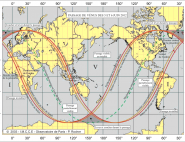Earth’s climate in the 17 th century
After the particularly mild weather of the Renaissance period, Earth’s climate gradually cooled and winters became very severe in the second half of the 17 th century. This period coincided with the Maunder minimum between 1645 and 1710 during which few sunspots were noted. The resulting energy deficit calculated as explained above matches the drop in temperature observed or reconstructed from numerous indicators such as tree-ring growth (dendrochronology) and spores or pollen (palynology). However, a more precise reconstruction than is currently available is needed for this period when there were big climate variations and the Sun was exhibiting singular and unique conditions on the historical scale.
How can Picard help to validate the historic reconstruction of solar brightness?
By establishing the relationship between the diameter of the Sun’s photosphere and solar activity, and assuming that solar mechanisms are not completely chaotic, as shown by its periodic cycles, we can deduce the Sun’s brightness. Since the 17 th century, solar eclipses have provided precise measurements of the diameter, using the Moon as a gauge. However, the eclipse phase in the Saros cycle needs to be taken into account. In particular, the 1715 eclipse would help to validate the reconstruction of brightness following the end of the Maunder minimum.


